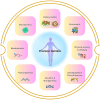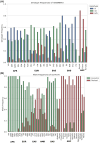Precision nutrition across climates: decoding diet, tradition, and genomic adaptations from South Asia to the Arctic
- PMID: 40896188
- PMCID: PMC12392652
- DOI: 10.3389/fnut.2025.1638843
Precision nutrition across climates: decoding diet, tradition, and genomic adaptations from South Asia to the Arctic
Abstract
Human populations have developed distinct genetic adaptations to diet in response to changes in lifestyle and environments in which they live. Particularly contrasting patterns of dietary adaptations are expected in populations living in tropical versus extreme cold environments. This article explores the genetic, dietary, and microbiome-related adaptations in populations of South Asia and the Arctic. We review adaptations related to high-carbohydrate, plant-based diets in South Asians and compare these against adaptations in Arctic populations who have evolved to rely on fat- and protein-rich diets from marine and animal sources. We discuss how these genetic adaptations interact with traditional diets and microbiomes, and the implications for chronic disease risks as modern, westernized diets disrupt ancestral gene-diet-microbiome interactions. By comparing these regions, we highlight the need for genome-based nutrition created strategies that account for genetic diversity, local dietary traditions, and environmental context to promote precision health and prevent diet-related chronic diseases. This analysis offers new insights into how nutrition, culture, and genetics intersect in shaping population-specific health outcomes.
Keywords: Arctic; South Asia; genetic variation; genome nutrition; natural selection; nutrigenetics; precision nutrition; traditional diet.
Copyright © 2025 Pathak, Kolesnikova, Sambreker, Org and Kivisild.
Conflict of interest statement
The authors declare that the research was conducted in the absence of any commercial or financial relationships that could be construed as a potential conflict of interest.
Figures





Similar articles
-
Prescription of Controlled Substances: Benefits and Risks.2025 Jul 6. In: StatPearls [Internet]. Treasure Island (FL): StatPearls Publishing; 2025 Jan–. 2025 Jul 6. In: StatPearls [Internet]. Treasure Island (FL): StatPearls Publishing; 2025 Jan–. PMID: 30726003 Free Books & Documents.
-
The risks, benefits, and resource implications of different diets in gastrostomy-fed children: The YourTube mixed method study.Health Technol Assess. 2025 Jul;29(25):1-21. doi: 10.3310/RRREF7741. Health Technol Assess. 2025. PMID: 40620081 Free PMC article.
-
Hail Lifestyle Medicine consensus position statement as a medical specialty: Middle Eastern perspective.Front Public Health. 2025 Jun 20;13:1455871. doi: 10.3389/fpubh.2025.1455871. eCollection 2025. Front Public Health. 2025. PMID: 40620567 Free PMC article.
-
Precision Nutrition for Management of Cardiovascular Disease Risk during Menopause.Lifestyle Genom. 2024;17(1):93-101. doi: 10.1159/000540337. Epub 2024 Jul 24. Lifestyle Genom. 2024. PMID: 39047690 Free PMC article. Review.
-
How lived experiences of illness trajectories, burdens of treatment, and social inequalities shape service user and caregiver participation in health and social care: a theory-informed qualitative evidence synthesis.Health Soc Care Deliv Res. 2025 Jun;13(24):1-120. doi: 10.3310/HGTQ8159. Health Soc Care Deliv Res. 2025. PMID: 40548558
References
-
- Precision Nutrition . (2020). The Nutrition Source, 23 September. Available online at: https://nutritionsource.hsph.harvard.edu/precision-nutrition/ (Accessed: 9 December 2024).
Publication types
LinkOut - more resources
Full Text Sources

